Key in a search term below to search our website.
Key in a search term below to search our website.
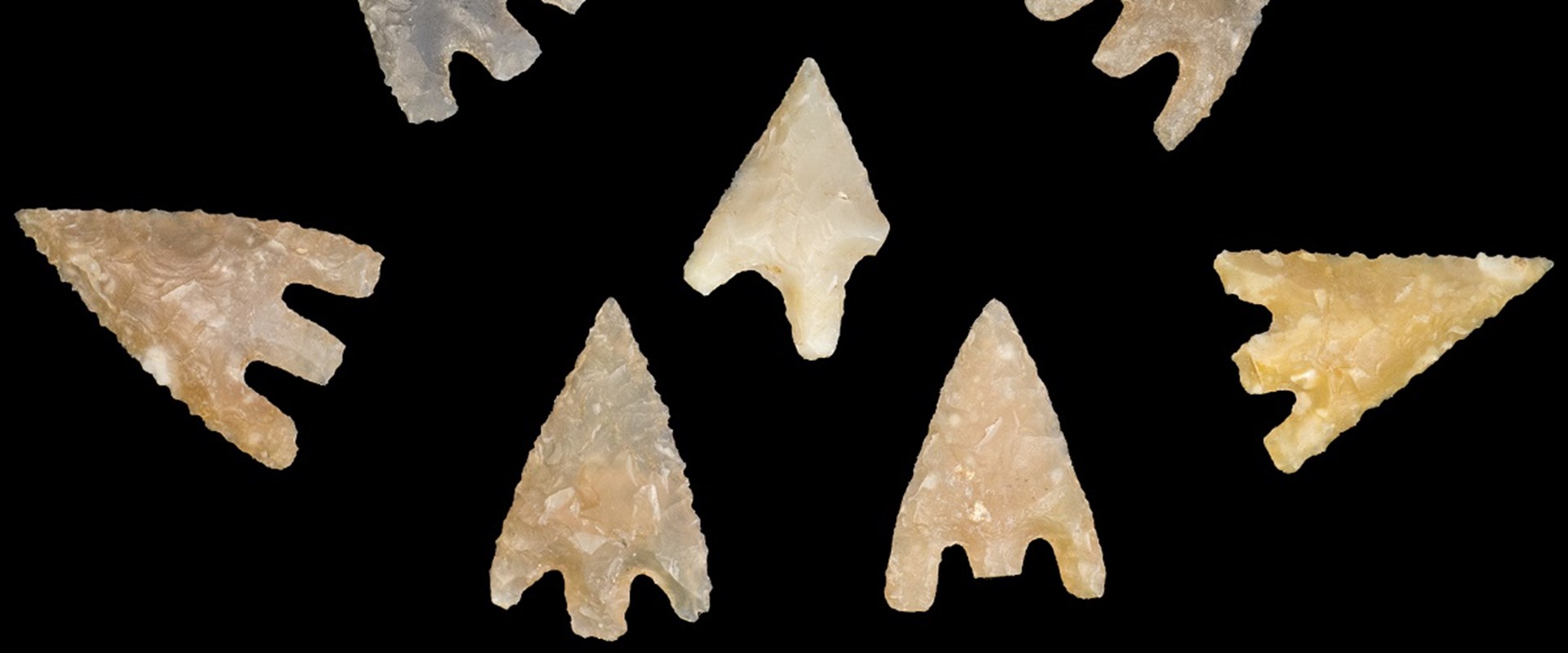
In 1975, a Bronze Age burial was uncovered near Culduthel Mains, Inverness-shire. Often interpreted as an archer, this man and his objects reveal fascinating stories about connections across Scotland and the rest of Britain and Ireland.
The burial assemblage was discovered in 1975 when a contractor’s vehicle broke through the cover of a stone-capped cist. An emergency excavation was then carried out, uncovering the remains of a man and the several objects that had been buried alongside him.
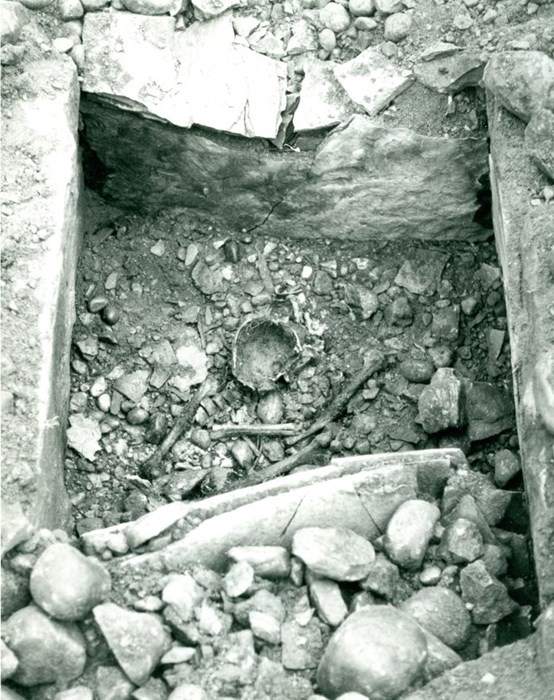
The excavated burial cist. Fragments of the beaker can be seen towards the left of the cist. Image reproduced with the permission of Inverness Museum and Art Gallery, High Life Highland.
During the 25th and 24th centuries BC, Scotland saw the arrival of the so-called ‘Beaker People.’ The ‘Beaker People’ were travellers from mainland Europe and their name arises from the continental-style of pots, called Beakers, that they brought over with them. The production and burial of Beakers became a long-standing tradition, evidenced by the Beaker buried with the Culduthel man.
By the end of the second millennium BC, it became common for people to be buried individually in stone-lined cists. People were sometimes buried with grave goods, including pottery, ornaments and stone artefacts. Sometimes these reflect aspects of the life of the deceased or were gifts by the community burying the body. The Culduthel man is a good example of this tradition.
The cist contained the body of a man who died when he was around 35–40 years old. Radiocarbon dating has now shown that he lived and died around 2280-2020 BC. This places him around the end of the Chalcolithic period or the start of the Bronze Age period.
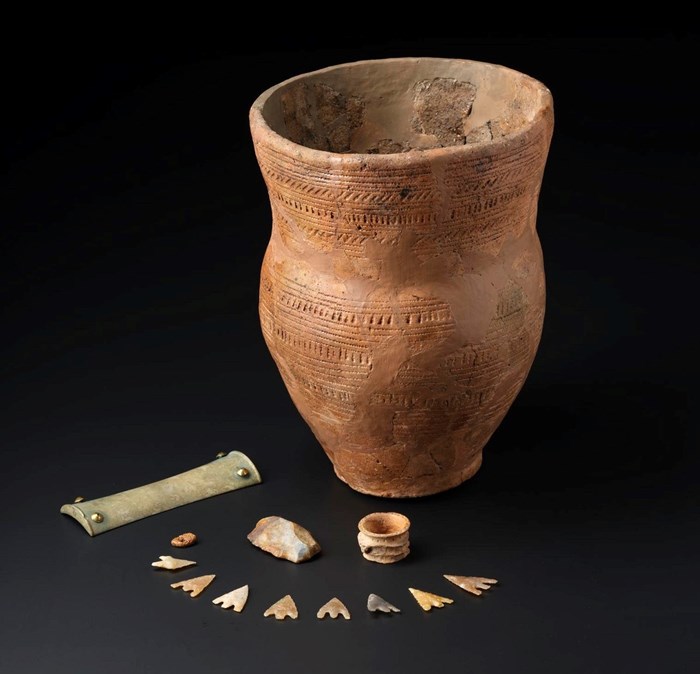
The Culduthel Mains burial assemblage (X.EQ 843-855).
He was discovered in a crouched position with a Beaker by his head and other objects around him. The Culduthel Beaker can hold around 2-3 litres and most likely held a liquid food or drink of some sort. It has been suggested that the drink, perhaps milk or ale, would have been for the man to take with him in the Afterlife. The Beaker was placed into the grave whole and upright but had become fragmented some time during the years it spent underground. It has since been reconstructed. The Beaker is beautifully decorated with bands of horizontal comb-stamped lines.
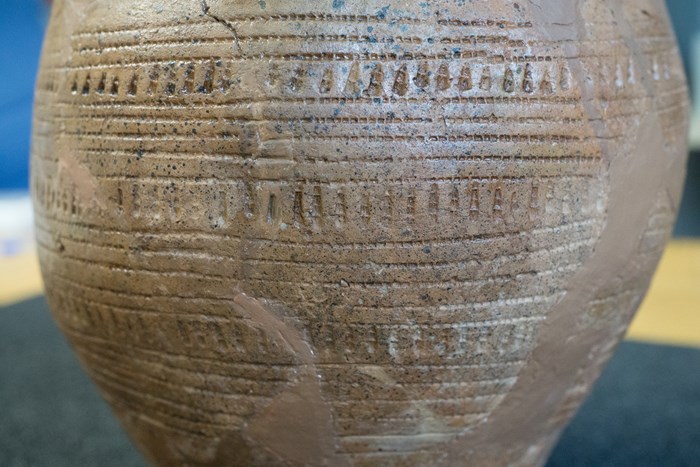
Close up of the comb-stamped decoration on the Culduthel beaker (X.EQ 843).
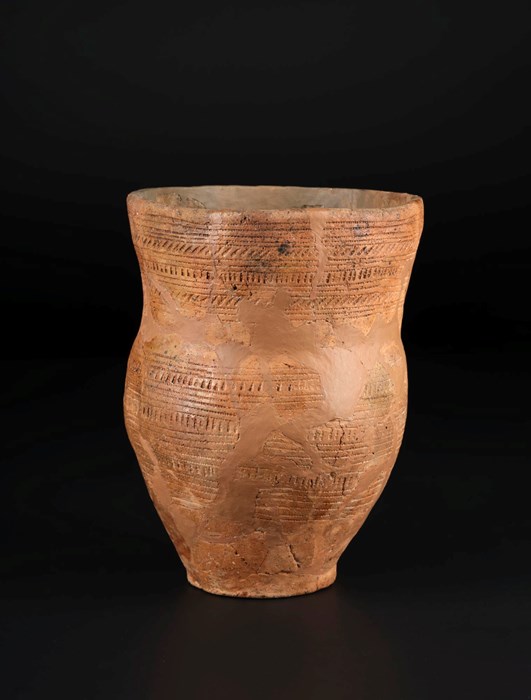
Comb decorated beaker from the Culduthel burial (X.EQ 843).
We also know the man was well-travelled. Isotopic analysis of enamel from one of his molar teeth indicates that he probably grew up in what is now County Antrim in north-east Ireland and travelled to Scotland in later life. The nature of his burial suggests he may have been well-respected and held an important position within the community away from his childhood home.
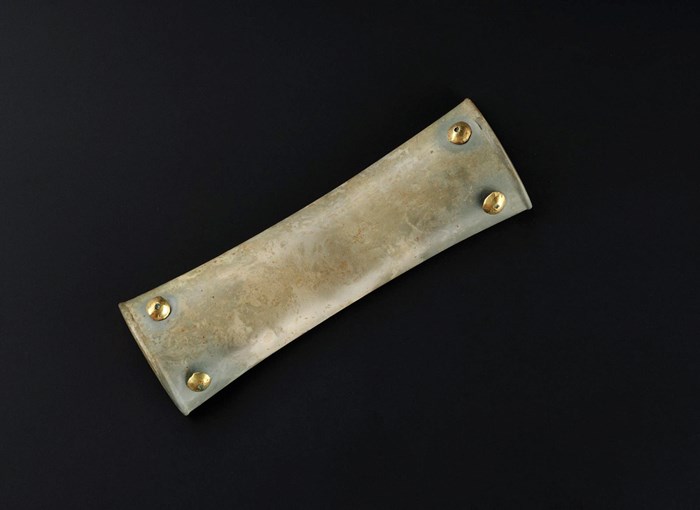
Stone wristguard with gold capped rivets from the Culduthel burial (X.EQ 844).
The objects themselves also suggest just how widely connected this man was. The stone ‘wristguard’ is of particular interest. This is a finely made ornament that would have been riveted to an actual wristguard of hide, used to protect the wrist from the recoil of a bowstring when firing an arrow. The fine nature of the object suggests it may have been a ceremonial piece, perhaps produced specifically to be buried alongside this man.
The wristguard was made of a particular type of stone called tuff from Great Langdale in the Lake District, which is around 300 miles away from Culduthel. The rivets are made from copper capped in gold, another unusual feature of this type of object. This is one of only three wristguards with gold caps known from Britain and you can read more about the wristguard here.
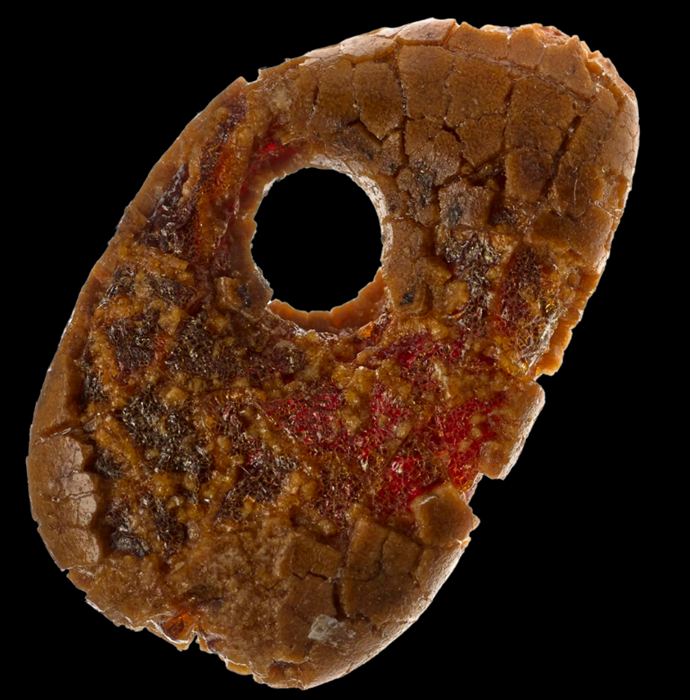
An amber bead crafted for wearing on a necklace from the Culduthel burial (X.EQ 846).
The man was also buried with an amber bead. Amber was a rare material in Scotland, but a small pebble of amber could have been collected from a coast nearby and crafted to be worn around the neck.
This was a well-travelled man who possessed objects that reflected varied connections. The wristguard was well-made and the arrowheads were also beautifully crafted and seemingly unused. The arrowheads may have been made for the burial and designed to construct the idea of the person being buried. The wristguard and arrowheads means the Culduthel man has often been interpreted as an ‘archer’.
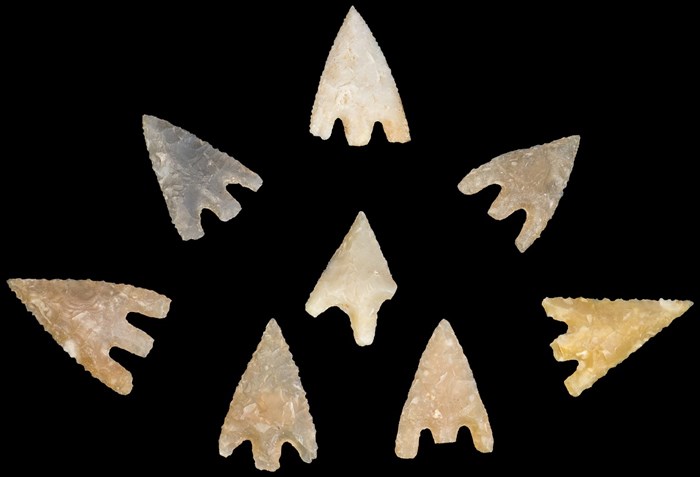
Finely made arrowheads from the Culduthel burial (X.EQ 848-855).
Other objects in the burial have shown signs of heavy use, suggesting that they were the man’s personal objects. A flint strike-a-light was found in the burial, which would have been used to start fires. The amber bead also shows signs of wear, suggested that it had been worn prior to being placed in the burial. A bone ring was also found. This may have been worn on his belt. This too was beautifully decorated and perhaps adorned the man during his life.
There are still many questions that remain unanswered from this site. Why did this man travel to Scotland? How did he come to be buried at Culduthel? We may never know the answers to these questions. However, the objects he was buried with tell a story about the man’s identity in life and death.
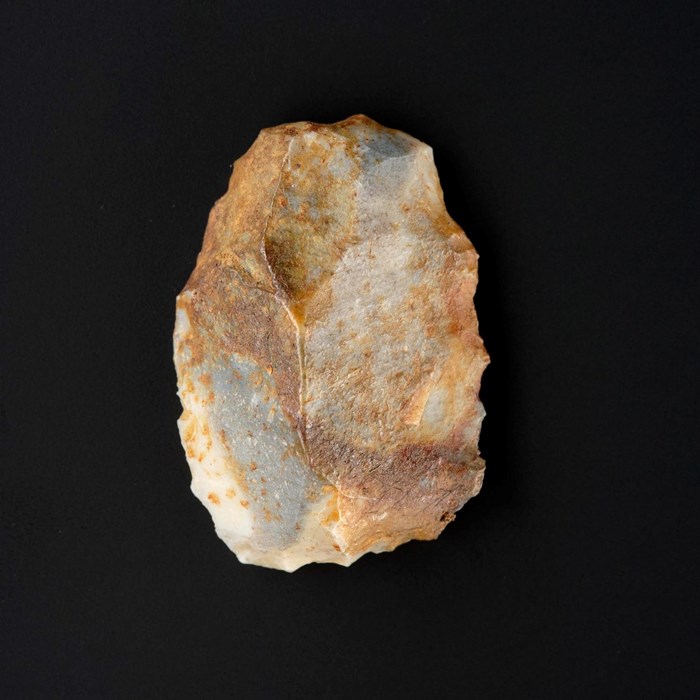
A well-used flint strike-a-light for starting fires from the Culduthel burial (X.EQ 847)
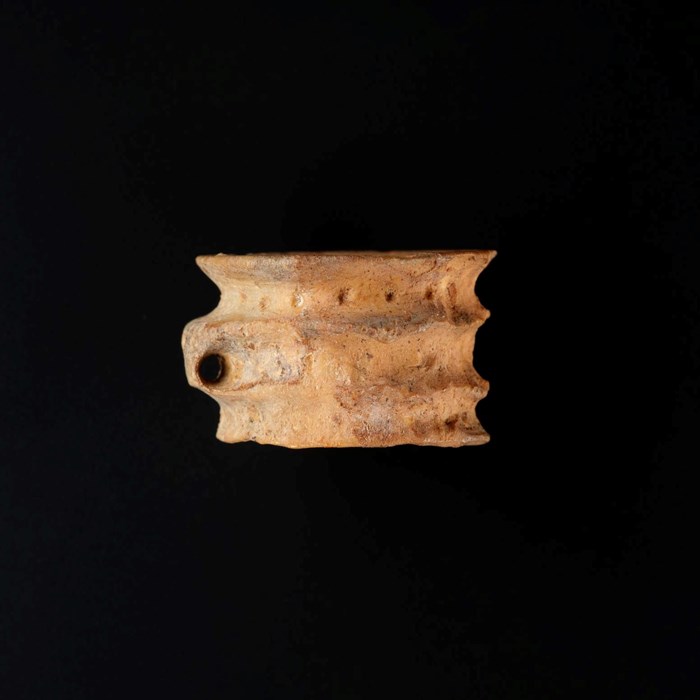
Bone ring, most likely for wearing on a belt from the Culduthel burial (X.EQ 845)
Date
Early Bronze Age (2280-2020BC)
Found
24 November 1975 at Culduthel Mains, Inverness-shire
What was found
Burial of a man in a stone-lined cist alongside a beaker, a strike-a-light, a bone ring, an amber bead, a stone wristguard with gold-capped copper rivets, and 8 flint arrowheads
Acquired
1976
On display
Early People, Level -1, National Museum of Scotland
Did you know
Analysis of the man’s teeth shows that he probably grew up in Ireland and travelled to Scotland later in life.